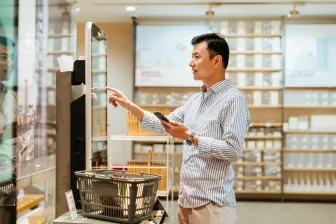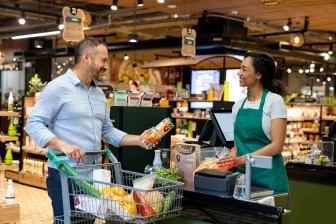Contactless 2021: Will a £100 contactless limit be the final nail in the coffin for cash payments in the UK

Cash payments have been in decline over the past decade, with contactless payment becoming the popular choice thanks to the convenience of a simple tap.
This efficiency benefits both merchants and consumers, and since the COVID pandemic swept over the globe, the crash of cash has accelerated with most consumers seeing contactless as the ideal, ‘germ-free’ solution to the unsanitary business of passing change from one sweaty palm to another.
To further encourage the switch to contactless, the CVM limit (the ceiling which a transaction can reach before the card needs to be inserted), was increased from £30 to £45 in April 2020. This 50% increase, brought forward and introduced at speed, reduced the need for consumers to touch the payment device, helping to curb the potential spread of coronavirus and further convincing the population to move away from cash. Those who stuck with cash previously because it’s “what they know”, and who converted to contactless for hygiene reasons, have had a taste for its convenience and will be unlikely to switch back to cash again.
With the CVM limit on contactless transactions in the UK now set to more than double to £100 by the end of the year, what chance does cash stand? For many households, that’s a week’s shopping at the tap of their card and when you consider the original limit of £30, which will have more than tripled by the end of 2021, it’s fair to reason that contactless will become the dominant mode of payment at the POS.
Will lifting the lid on contactless increase the volume of fraudulent transactions?
On face value, the increase appears pretty tasty for opportunistic criminals. Being able to get away with £100 of goods per transaction, without needing anything other than a stolen or misplaced card, seems too good to be true!
However, criminals rubbing their hands together beware, thanks to a recently introduced set of rules designed to protect consumers: Strong Customer Authentication (SCA). SCA was created to add extra security to online payments by forcing consumers to confirm their identity when they pay for something. The rules also extend to all other forms of payment, including contactless transactions, since before SCA there was no need to prove who you are during a contactless transaction; all you had to do was tap the card.
The SCA rules define that transactions below £45 are considered low value and are exempt, so currently that’s all contactless payment below the limit. However, when five consecutive unauthenticated low value transactions are made on the same card, or the total value of the consecutive unauthenticated low value payments exceeds £130, SCA will then be required, meaning the customer will have to provide additional authentication, such as entering their PIN or fingerprint. This allows for some damage limitation for lost or stolen cards; if one of the SCA criteria is met, those committing fraud will not be able to provide the extra level of authentication required.
What will be the impact of a £100 contactless limit on SCA?
The arrival of the increase in contactless transactions will also see a rise in the limits involved in SCA. The trigger point for a single contactless transaction to be considered for SCA will become £100, and the cumulative limit will be increased from £130 to £300.
In practice, this means that a fraudster who has a lost or stolen card will be able to perform £300 worth of purchases (if they reach that limit in under 5 transactions) before they’re asked to prove their identity.
This sounds a little scary, both for consumers and the banks who carry the risk. But in practice, those are the minimum standards banks must adhere to, they could request additional authentication for any contactless transaction that real-time monitoring suggests might be fraudulent. With the world reopening its doors and crowds becoming more common again, there will be more opportunity for theft and it’s certain that a close eye will be kept on the level of contactless fraud. The need for real time fraud monitoring systems will become greater with time.
What’s the future for cash in the UK?
Regardless of the security concerns around contactless transactions and despite its roaring success, cash still maintains a significant presence in the UK:
- According to The Guardian, cash accounted for 17% of all payments in the UK in 2020. Almost one in five payments were taken in cash, even during the pandemic, and with businesses reopening and the vaccine rollout increasing consumer confidence, the incentive to avoid using cash will start to creep towards the back of people’s minds.
- A strange fact that also merits consideration is the Bank of England’s data which shows that the number of bank notes in circulation has actually increased over the course of the pandemic, with people withdrawing and holding on to cash. It’s bizarre, granted, but it cannot be ignored that while the number of cash transactions are decreasing, there’s a growing quantity of cash being held by the population which has been deemed a reaction to the uncertainty surrounding COVID and Brexit.
- There are other factors to consider too; some small businesses still rely on cash. A report from NatWest suggests that while merchants are moving with more speed towards digital payments, and that this transition has been accelerated by the pandemic, there is still a large number of small businesses that only operate with physical money. If cash is to truly disappear then digital payments will need to become a lot more accessible for smaller businesses.
- Another example of the continued reliance on cash is the use of vending machines. While contactless capable vending machines are becoming more common, many still rely on consumers inserting their loose change and notes.
- Finally, a significant proportion of the population grew up using cash payments as the norm, and there remain those who are unwilling to adopt contactless or even chip and PIN in some cases. There is still a large number of adults in the UK who simply don’t have a bank account with the last World Bank report placing this figure at 4%, or 2.1M people. It’s possible that some will never adapt in their lifetime to a cashless society, either because they are unable to do so, or simply because they don’t wish to.
The days of cash are numbered
The use of cash as a means of payment is on the way out. A £100 contactless limit will propel cashless payments forward and cash will continue its decline… but we can’t count cash out just yet.
Even with the £100 limit, the rate at which cash declines will start to slow down with the worst of the pandemic over and a significant chunk of the population who remain loyal to a form of payment they can see with their own eyes.
In the longer term, this scepticism will disappear and be replaced by younger generations brought up in the digital age. When we do move to a truly cashless society, it will lead to exciting innovations and more new ways of performing and managing the act of payment.










